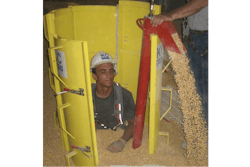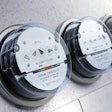Transcription of Feed & Grain Chat withRyan Moorman, Vice President and Project Manager for Rolfes@Boone.
Elise Schafer, editor, Feed & Grain:Welcome toFeed & Grain Chat. I'm your host Elise Schafer, editor ofFeed & Grainmagazine. This edition ofFeed & Grain Chatis brought to you by WATT Global media andFeedandgrain.com. Feedandgrain.com is your source for the latestnews, product and equipmentinformationfor the grain handling and feed manufacturing industries.
Today I'm joined on Zoom by Ryan Moorman, vice president and project manager for Rolfes@Boone. He's here to talk about grain cooling and conditioning, and how to keep aeration systems in top shape over the summer months. Hi, Ryan, thank you for joining me today.
Ryan Moorman, Vice President and project manager for Rolfes@Boone:Hey, Elise, thanks for having me. Thanks so much for bringing me on.
Schafer:Yeah, let's get right into it! Harvest preparation for co-ops and grain handlers means equipment maintenance season. Can you discuss what kind of annual maintenance and cleaning is key for optimal aeration fan performance?
Moorman: Yeah, absolutely. You know, when specifically talking about aeration fans, whether that's centrifugal fans, axial fans or your rooftop exhausters, there's certainly a few things that you want to look out for when getting ready for harvest. The No. 1 thing would be to check the for any debris or build up garbage, bird nests, anything like that on the actual fan wheel or blade.
If you do have any buildup, you want to make sure that that gets cleaned. Make sure that your wheel or blade is still in balance and that any any debris is removed from from there at that time. Once that's done, you want to go ahead and check your motor and make sure that it's still spinning freely and correctly, as well as lubricated and greased per the manufacturer's recommendation.
And then lastly, with your aeration fans, really what you want to do is to check the housing for any cracks or rust holes, anything like that. Make sure that those are getting repaired or replaced as needed, and everything's good on that end. You know, aeration fans really should last a really long time, you know, 20-plus years 30-plus years when used properly and maintained properly.
Schafer:So, temperature cables are commonly used in grain bins to determine when and for how long to run aeration systems. Do you have any recommendations for maximizing cable functionality or longevity?
Moorman:Yeah, absolutely. You know, the cable system's a very important part for a grain handling facility in their decision making process. And in order to make the best decisions, you've got to have accurate and quick information. So, prior to filling these bins during harvests, there are a few things that you want to check. Firstly, you want to get in there while the bins empty and make sure that there aren't any knots in the cables themselves, and that they are secured properly to the bottom of the floor bin.
Next, you want to go through and use your your own reading feature on your cable reader. This will check all of your sensors to see if they're working properly or not. If you do have some sensors out on a cable, it's really not that big of a deal. Really, what you're looking for is having two or three consecutive sensors that are out and and causing a large gap in your coverage in your bin. If that's the case, then yes, you will want to have your cable replaced at that time.
Third, you want to double check and clean out any portable reading boxes, make sure there's no debris in there. You want to inspect your conduit and lead wire for any damage. Whether that's you know, an accident orrodentsor whatever it might be, you want to make sure that you're good there. And then lastly, you want to make sure that you're doing a number of test runs through your whole temperature monitoring system prior to harvest, to make sure that everything is working properly as you like it. And if not, you can bring in a service crew at that time, if needed.
Schafer:Excellent. Aeration ducts are another component for grain conditioning and cooling. How often should ducts be inspected or replaced?
Moorman:Sure, yeah. So, whether we're talking about, you know, full round ducts , or half round ducts, or aeration shading and a flush floor system, you know, we recommend that that your materials are are inspected, every time that you empty the bin. Anytime that you can get in there and check those out is a good time to go do that. You know, over time, those perforations can become clogged, especially if you're having to store a higher moisture commodity in there. That's when you tend to see those issues. So, each time that the bin's empty, get in there, look for any clogging going on, make sure that that gets cleaned out. And at that time, you're also looking for any damage to ductwork, whether it might be crushed, whether it might be rusted, or any large holes in the sheets or anything like that. You want to make sure that you don't have any areas of leakage is really what you're looking for. You know, a damaged aeration system isn't able to perform properly as designed, and when that's the case, obviously it's putting that whole bin at risk. And that's the last thing that we want to see.
Schafer:Absolutely. Now, when we're talking about maintenance, inspections — anything that has to be done around electrical, or if there's a potential for confined space entry — safety is always a concern. Can you talk about the role of safety procedures, whether it's your team conducting maintenance, or someone doing it on their own facility?
Moorman:Yeah, absolutely. You know, safety is obviously a huge priority and our No. 1 priority. So, you know, the truth of the matter is, we work around large, heavy moving equipment at a grain handling facility, so the job is just inherently dangerous. And so, again, we always have to keep safety at the forefront. You know, whether we're talking about a lockout tagout procedure, using proper PPE, or using co2 monitors in confined spaces, whatever it might be, we like to make sure that our guys when they get on site, they have a meeting with the facility manager or whoever's in charge at that time to make sure that all these things are planned. They're discussed ahead of time, they're planned for ahead of time and there's no surprises later on.
You know, a lot of times there's there's a lot of pressure to get these jobs done as quickly as possible, both from the customer and from the bosses at times, but safety always has to remain the No. 1 priority. The big thing that we talk about is if at any time if you're not sure, just stop and ask questions — stop and ask for help. Stop in and make sure that you're proceeding safely and in a proper way. You know, we talk all the time about the No. 1 goal of the day is to make sure that everyone gets to go home safely. And that really is our focus when we're out on a job site.
Schafer:Great tips. Well, thank you for your time today. That's all the questions I had for you. Appreciate you coming on, Ryan.
Moorman:Great. Thank you so much, Elise. Really appreciate it.
Schafer:Thank you for watching this edition ofFeed & Grain Chat. Be sure to tune in for my next edition right here atFeedandgrain.com.
A properly maintainedaeration systemis key tocoolingand conditioning stored grain — especially over the summer months. As facility preparation for harvest gets underway across the U.S.,Feed & Graincaught up with Ryan Moorman, vice president and project manager forRolfes@Boone, to share tips on inspecting and maintaining aeration system components from fans to motors, temperature cables and ductwork.






















